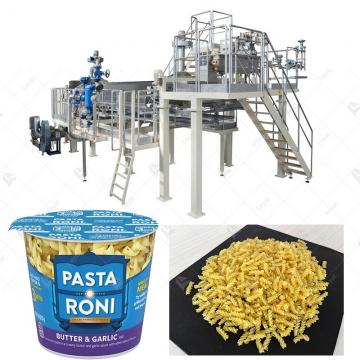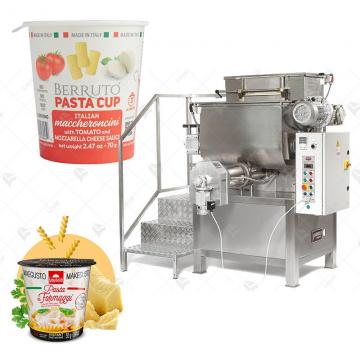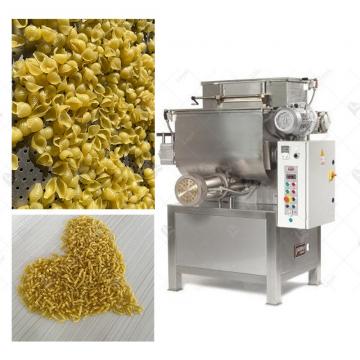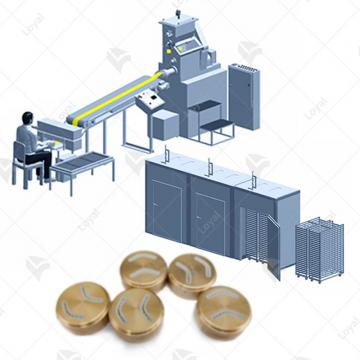
- Shandong Loyal Industrial Co.,Ltd.
- SHORT-CUT PASTA PRODUCTION LINE LONG-CUT PASTA PRODUCTION LINE INSTANT PASTA PRODUCTION LINE
Home> Company News> The Ultimate Guide to Combined Pasta Production Lines in 2024: A Global Perspective

The Ultimate Guide to Combined Pasta Production Lines in 2024: A Global Perspective
2024-03-27 16:39:53Introduction
In the bustling world of food production, pasta stands as a timeless favorite, cherished for its versatility and comfort appeal. The combined pasta production line represents a pinnacle of efficiency in this industry, seamlessly integrating various processes to meet the demands of modern consumers. This ultimate guide aims to shed light on the significance of combined pasta production lines, offering a comprehensive overview of their role, purpose, and scope in shaping the pasta manufacturing landscape.
Key Features and Functionalities of modernCombined Pasta Production Lines
Modern combined pasta production lines boast advanced features and functionalities designed to meet the evolving needs of the food industry. These include precise control systems for dough consistency and pasta shape, automated cleaning and sanitation processes to ensure food safety and hygiene, and integrated quality control systems to monitor product quality throughout the production process. Furthermore, many combined pasta production lines are equipped with smart sensors and data analytics capabilities, allowing manufacturers to optimize production parameters in real time and minimize waste. Overall, the key features and functionalities of modern combined pasta production lines empower manufacturers to achieve higher levels of efficiency, consistency, and quality in pasta production.
Overview of Pasta Production Industry
The pasta production industry stands as a cornerstone of the global food market, catering to diverse tastes and preferences worldwide. From traditional Italian delicacies to innovative fusion creations, pasta continues to captivate hearts and taste buds alike. Within this dynamic industry, short-cut pasta production lines and long-cut pasta production lines play integral roles, facilitating the efficient mass production of pasta products to meet consumer demands.
Short-cut pasta production lines are tailored for the production of pasta varieties characterized by their short, compact shapes, such as penne, fusilli, and macaroni. These production lines are equipped with specialized machinery designed to extrude, cut, and shape dough into uniform pieces with precision and speed. By leveraging advanced technology and automation, short-cut pasta production lines ensure consistency in shape, texture, and quality, meeting the exacting standards of consumers and manufacturers alike.
Long-cut pasta production lines, on the other hand, are optimized for the production of pasta varieties distinguished by their elongated, ribbon-like shapes, such as spaghetti, fettuccine, and linguine. These production lines feature continuous extrusion systems capable of producing long strands of pasta dough, which are then cut to desired lengths and dried to perfection. With meticulous attention to detail and adherence to traditional pasta-making techniques, long-cut pasta production lines deliver pasta products that uphold the rich heritage and culinary traditions of pasta craftsmanship.
Significance of Combined Pasta Production Lines
Amidst the evolving landscape of food manufacturing, efficiency reigns supreme. Combined pasta production lines offer a holistic solution to streamline the pasta production process, from dough preparation to packaging. By integrating multiple stages into a single, cohesive system, these production lines optimize resource utilization, reduce production downtime, and ensure consistent quality across all pasta varieties. In an industry driven by consumer preferences and market trends, the significance of combined pasta production lines cannot be overstated.
One of the key advantages of combined pasta production lines is their ability to optimize resource utilization. By centralizing various production stages, such as dough mixing, extrusion, shaping, and drying, these lines minimize the need for manual labor and equipment duplication. This streamlined approach not only reduces operational costs but also maximizes the use of raw materials, energy, and floor space. As sustainability becomes increasingly important in the food industry, the efficient resource utilization offered by combined pasta production lines aligns with environmentally conscious practices and regulatory requirements.
Consistency is paramount in pasta manufacturing to maintain customer satisfaction and brand reputation. Combined pasta production lines excel in ensuring consistent quality across all pasta varieties, whether it's short-cut or long-cut. By employing advanced technologies, such as automated monitoring systems and precise control mechanisms, these production lines minimize variations in product characteristics such as texture, shape, and taste. This consistent quality assurance not only enhances the overall consumer experience but also fosters trust and loyalty towards the brand.
Definition and Components of Combined Pasta Production Lines
In the dynamic landscape of food manufacturing, the combined pasta production line stands as a cornerstone of efficiency and innovation. This sophisticated system integrates multiple stages of pasta production into a seamless operation, from dough preparation to packaging. A combined pasta production line typically comprises several key components, including:
1. Dough Mixers: These machines are responsible for blending the ingredients needed to make pasta dough, including flour, water, and sometimes eggs. Modern dough mixers often feature precise controls for achieving the desired consistency and texture of the dough.
2. Extruders: Extruders are crucial components that shape the pasta dough into various forms, such as tubes, shells, or strands. These machines exert pressure on the dough to push it through a die, forming the desired pasta shapes.
3. Cutters: Cutters are used to slice or portion the extruded pasta dough into the desired lengths or shapes. They can be adjustable to accommodate different pasta varieties, such as short-cut or long-cut pasta.
4. Dryers: After shaping, the pasta needs to be dried to remove excess moisture and prevent spoilage. Dryers are specialized machines equipped with controlled temperature and airflow systems to facilitate the drying process while preserving the pasta's texture and flavor.
5. Packaging Machines: Once the pasta is dried to the desired moisture content, it is ready for packaging. Packaging machines efficiently portion the pasta into individual servings and seal them in bags or containers, ready for distribution to consumers.
These components work in tandem to streamline the production process and optimize output, ensuring consistent quality across all pasta varieties. Each component plays a critical role in the overall efficiency and effectiveness of the combined pasta production line, contributing to its reputation as a versatile and indispensable asset in the food manufacturing industry.
Advantages and Benefits of Utilizing Combined Pasta Production Lines
One of the primary advantages of combined pasta production lines is their ability to enhance cost efficiency and productivity. By automating repetitive tasks and integrating multiple production stages, these lines significantly reduce the need for manual labor, thereby lowering labor costs and minimizing human error. Moreover, the streamlined workflow and optimized processes result in increased overall productivity, allowing manufacturers to meet higher production demands without compromising on quality.
Another key benefit of utilizing combined pasta production lines is the ability to achieve superior quality control and consistency in pasta production. These production lines are equipped with advanced monitoring and control systems that ensure precise control over factors such as dough consistency, pasta shape, and cooking time. As a result, manufacturers can consistently produce pasta products that meet stringent quality standards and exceed customer expectations. This focus on quality control not only enhances consumer satisfaction but also strengthens brand reputation in the competitive food industry.
In today's fast-paced market, staying ahead of evolving consumer preferences and market trends is essential for success. Combined pasta production lines offer manufacturers the flexibility and adaptability needed to respond quickly to changing market demands. Whether it's introducing new pasta shapes, flavors, or packaging formats, these production lines enable manufacturers to innovate and diversify their product offerings to stay relevant and competitive. By leveraging the versatility of combined pasta production lines, manufacturers can capitalize on emerging trends and seize new opportunities for growth and expansion.
Preparing for Installation And Setup
When setting up a combined pasta production line, meticulous preparation is essential to ensure smooth installation and operation. Firstly, manufacturers must assess their production requirements and space constraints to determine the optimal layout for the production line. This involves conducting thorough site surveys and consulting with engineers to identify any potential challenges or obstacles. Additionally, preparing the site infrastructure, such as electrical and plumbing systems, is crucial to support the operation of the production line effectively. By taking these preparatory steps, manufacturers can lay the foundation for a successful installation process and minimize disruptions to production.
Selecting The Right Equipment And Machinery
Selecting the appropriate equipment and machinery is a critical step in setting up a combined pasta production line. Manufacturers must carefully evaluate their production needs, budget constraints, and technical requirements to choose the right components for their line. When selecting equipment, factors such as production capacity, versatility, and ease of maintenance should be taken into consideration. Additionally, manufacturers should prioritize equipment from reputable suppliers with a proven track record of reliability and quality. By investing in the right equipment, manufacturers can ensure the efficiency, performance, and longevity of their short-cut pasta production line and long-cut pasta production line.
Ensuring Safety Protocols And Compliance With Regulations
Ensuring safety protocols and compliance with regulations is paramount when setting up a combined pasta production line. Manufacturers must adhere to industry standards and regulatory requirements to safeguard the health and well-being of workers and consumers. This involves implementing comprehensive safety protocols, such as proper machine guarding, emergency stop systems, and employee training programs. Additionally, manufacturers must ensure compliance with food safety regulations, such as Hazard Analysis and Critical Control Points (HACCP) guidelines, to prevent contamination and ensure product quality. By prioritizing safety and regulatory compliance, manufacturers can create a secure and compliant working environment while maintaining the integrity of their pasta production process.
Workflow And Process Overview
Operating a combined pasta production line involves a series of carefully coordinated processes to ensure efficient and seamless pasta production. The workflow typically begins with the preparation of the pasta dough, which is then fed into the extrusion system of the production line. Here, the dough is shaped into various pasta forms, including both short-cut pasta and long-cut pasta, depending on the specific configuration of the production line. Once extruded, the pasta is then transported through a drying chamber to remove excess moisture before being cut into individual portions. Finally, the finished pasta is packaged and prepared for distribution to consumers. Throughout this workflow, strict adherence to quality control measures and production standards is essential to ensure the consistent quality and safety of the final product.
Maximizing Efficiency And Productivity
Maximizing efficiency and productivity is a top priority when operating a combined pasta production line. One strategy for achieving this is through the optimization of production parameters, such as line speed, dough consistency, and drying temperature. By fine-tuning these parameters to match the specific requirements of each pasta variety, manufacturers can minimize production downtime and maximize output without compromising on quality. Additionally, investing in advanced automation and control systems can further enhance efficiency by reducing reliance on manual labor and minimizing the risk of human error. Regular maintenance and calibration of equipment are also critical to ensuring smooth operation and preventing unexpected breakdowns that can disrupt production schedules.
Troubleshooting Common Issues And Maintenance Tips
Despite meticulous planning and execution, short-cut pasta production lines and long-cut pasta production lines may encounter occasional issues that require troubleshooting and maintenance. Common issues include equipment malfunctions, ingredient inconsistencies, and variations in product quality. To address these issues effectively, it is essential to have a comprehensive understanding of the production line's components and operation. Regular inspection and preventive maintenance can help identify potential issues before they escalate into major problems, while prompt intervention and repairs can minimize downtime and ensure uninterrupted production. Additionally, maintaining open communication channels between production staff, maintenance technicians, and management can facilitate swift resolution of issues and promote a culture of continuous improvement within the production facility.
Equipment Malfunctions: One of the most common issues encountered in pasta production lines is equipment malfunctions. This can range from minor glitches to major breakdowns, impacting production efficiency and output. To troubleshoot equipment malfunctions effectively, it is crucial to conduct regular inspections and preventive maintenance checks. This includes monitoring the condition of machinery, lubricating moving parts, and replacing worn-out components as needed. Additionally, having a qualified maintenance team on standby to address any issues promptly can help minimize downtime and keep production running smoothly.
Ingredient Inconsistencies: Another common issue that can affect pasta production lines is ingredient inconsistencies. Variations in ingredient quality or composition can lead to deviations in product texture, taste, and appearance. To mitigate this risk, it is essential to source high-quality ingredients from reputable suppliers and conduct rigorous quality control checks throughout the production process. This includes testing raw materials for purity and consistency, adjusting ingredient ratios as needed, and calibrating equipment to ensure uniform product characteristics. By maintaining strict quality standards and monitoring ingredient inputs closely, manufacturers can minimize the risk of ingredient-related issues impacting production.
Variations in Product Quality: Maintaining consistent product quality is paramount in pasta manufacturing to meet customer expectations and uphold brand reputation. However, variations in product quality can occur due to factors such as equipment settings, processing parameters, and environmental conditions. To troubleshoot variations in product quality, it is essential to conduct thorough root cause analysis and identify the underlying factors contributing to the issue. This may involve adjusting equipment settings, fine-tuning processing parameters, or implementing additional quality control measures. By addressing the root causes of product quality variations proactively, manufacturers can ensure consistent quality standards and enhance customer satisfaction.
While short-cut pasta production lines and long-cut pasta production lines offer numerous benefits in terms of efficiency and productivity, they may encounter common issues that require troubleshooting and maintenance. By adopting proactive maintenance practices, conducting regular inspections, and fostering open communication channels, manufacturers can minimize downtime, address issues promptly, and ensure uninterrupted production of high-quality pasta products.
Quality Control Measures And Quality Assurance Processes
Quality control is paramount in pasta production to ensure that every batch meets the highest standards of excellence. In short-cut pasta production lines, quality control measures are implemented at each stage of the process, from dough mixing to packaging. Advanced sensors and monitoring systems are employed to assess key parameters such as dough consistency, pasta shape, and cooking properties. Additionally, rigorous testing protocols are in place to detect any deviations from specifications and address them promptly. Similarly, in long-cut pasta production lines, quality assurance processes are equally stringent, with meticulous attention to detail throughout the production cycle. By adhering to robust quality control measures and quality assurance processes, manufacturers can uphold consistency and reliability in their pasta products, earning the trust and loyalty of consumers.
Implementing Best Practices For Consistent Pasta Production
Consistency is the hallmark of successful pasta production, regardless of whether it's short-cut or long-cut varieties. To achieve consistent results, manufacturers must adhere to best practices at every stage of the production process. This includes using high-quality ingredients, maintaining precise control over production parameters, and adhering to standardized procedures. In short-cut pasta production lines, for example, extrusion and cutting processes must be carefully calibrated to ensure uniformity in pasta shape and size. Similarly, in long-cut pasta production lines, drying times and temperatures must be meticulously controlled to achieve the desired texture and cooking properties. By implementing best practices for consistent pasta production, manufacturers can deliver products that meet or exceed customer expectations, fostering brand loyalty and driving business growth.
Incorporating Technology and Innovation For Enhanced Performance
Technology and innovation play pivotal roles in optimizing the performance of both short-cut and long-cut pasta production lines. From advanced automation systems to cutting-edge manufacturing techniques, manufacturers are constantly exploring new ways to enhance efficiency and quality. In short-cut pasta production lines, for instance, the adoption of precision extrusion technology allows for greater control over pasta shape and texture, resulting in more uniform products. Similarly, in long-cut pasta production lines, innovations in drying technology have led to shorter drying times and improved energy efficiency, reducing production costs and environmental impact. By embracing technology and innovation, manufacturers can stay at the forefront of the industry, meeting the demands of today's consumers while paving the way for a more sustainable and prosperous future.
Global trends in Pasta Production and Consumption
The global pasta industry is witnessing significant growth and evolution, driven by changing consumer preferences, dietary trends, and socio-economic factors. Both short-cut pasta production lines and long-cut pasta production lines play crucial roles in meeting the increasing demand for pasta products worldwide. With the rising popularity of convenience foods and the growing awareness of healthy eating habits, pasta has become a staple in many households and restaurants across the globe. As a result, the pasta production and consumption trends continue to show upward momentum, with emerging markets contributing to the overall expansion of the industry.
Emerging Technologies And Innovations in Combined Pasta Production
In response to the evolving needs of the market, manufacturers are continuously exploring new technologies and innovations to enhance the efficiency and quality of pasta production. The integration of advanced automation, robotics, and artificial intelligence has revolutionized combined pasta production lines, enabling manufacturers to achieve higher levels of precision, consistency, and productivity. Additionally, innovations in sustainable packaging materials and production processes are gaining traction, driven by consumer demand for eco-friendly solutions. As technology continues to advance, the future of combined pasta production holds promise for even greater efficiency, sustainability, and product innovation.
Predictions For the Future of Combined Pasta Production Lines in 2024 And Beyond
Looking ahead, the future of combined pasta production lines appears promising, with continued growth and innovation on the horizon. As the global population continues to expand, so too will the demand for pasta products, driving manufacturers to invest in advanced production technologies and processes. Moreover, with increasing emphasis on sustainability and health-conscious consumer preferences, we can expect to see further developments in eco-friendly packaging, ingredient sourcing, and production practices within the pasta industry. Overall, the outlook for combined pasta production lines in 2024 and beyond is characterized by innovation, adaptability, and a commitment to meeting the evolving needs of consumers and the market.
Real-World Examples of Successful Implementation of Combined Pasta Production Lines
In the competitive landscape of food manufacturing, the implementation of short-cut pasta production lines and long-cut pasta production lines has led to numerous success stories and case studies. One notable example comes from a leading pasta manufacturer in Italy, which invested in a state-of-the-art short-cut pasta production line to meet growing consumer demand for their popular penne and fusilli pasta varieties. By integrating advanced automation and quality control systems, the company was able to significantly increase production capacity while maintaining strict quality standards. This successful implementation not only allowed the company to expand its market share domestically but also facilitated entry into new international markets, driving revenue growth and profitability.
Another compelling case study comes from a pasta production facility in the United States that upgraded its operations with a modern long-cut pasta production line. Facing challenges with inefficient production processes and inconsistent product quality, the facility sought to enhance its competitiveness in the market. With the implementation of the new production line, featuring improved extrusion technology and automated shaping systems, the facility was able to achieve remarkable results. Not only did the production line increase throughput and reduce production downtime, but it also enabled the facility to introduce new long-cut pasta varieties that quickly gained popularity among consumers. As a result, the facility experienced a significant boost in sales and profitability, solidifying its position as a leader in the pasta industry.
Lessons Learned and Insights From Industry Leaders
These success stories offer valuable lessons and insights for industry leaders looking to leverage short-cut pasta production lines and long-cut pasta production lines to drive business growth and profitability. One key takeaway is the importance of investing in cutting-edge technology and equipment to stay competitive in the market. By embracing innovation and adopting advanced production techniques, manufacturers can optimize their operations, improve product quality, and meet the evolving needs of consumers.
Additionally, effective collaboration and knowledge-sharing within the industry are essential for success. Industry leaders can learn from each other's experiences and best practices to overcome challenges and capitalize on opportunities. Whether it's optimizing production processes, implementing quality control measures, or exploring new market trends, sharing insights and lessons learned can help drive continuous improvement and innovation in the pasta manufacturing industry.
Impact of Combined Pasta Production Lines on Business Growth And Profitability
The impact of combined pasta production lines on business growth and profitability cannot be overstated. By streamlining production processes, increasing efficiency, and enhancing product quality, these production lines enable manufacturers to meet consumer demand more effectively, expand market reach, and drive revenue growth. Furthermore, the ability to produce both short-cut and long-cut pasta varieties on the same line offers versatility and flexibility, allowing manufacturers to adapt quickly to changing market dynamics and consumer preferences.
In conclusion, the successful implementation of short-cut pasta production lines and long-cut pasta production lines has had a transformative impact on the pasta manufacturing industry. Through real-world examples, lessons learned, and insights from industry leaders, it is evident that these production lines play a crucial role in driving business growth, profitability, and success in the competitive global market. As the industry continues to evolve, leveraging advanced technology and collaborative partnerships will be key to unlocking new opportunities and sustaining long-term success.
Recap of Key Points
In conclusion, the short-cut pasta production line and the long-cut pasta production line represent integral components of the modern pasta manufacturing industry. These specialized production lines cater to the diverse preferences of consumers by offering a wide range of pasta shapes and varieties. By understanding the distinct characteristics and functionalities of each type of production line, manufacturers can optimize their operations to meet the demands of the market effectively.
Final Thoughts on The Importance of Combined Pasta production Lines
The importance of combined pasta production lines cannot be overstated in today's competitive food industry. These sophisticated systems offer unparalleled efficiency, versatility, and quality assurance, enabling manufacturers to produce high-quality pasta products at scale. By streamlining workflows, minimizing production downtime, and optimizing resource utilization, combined pasta production lines empower manufacturers to stay ahead of the curve and meet the evolving needs of consumers.
Looking Ahead to The Future of Pasta Production Technology
As we look ahead to the future of pasta production technology, it is evident that innovation will continue to drive advancements in the industry. With the rapid pace of technological development, we can expect to see further improvements in automation, robotics, and data analytics, enhancing the efficiency and sustainability of pasta production processes. Moreover, the growing emphasis on environmental sustainability and health-conscious consumer preferences will likely influence the development of new pasta formulations and production methods. Overall, the future of pasta production technology holds exciting possibilities for continued growth, innovation, and success in the global food market.
References
1. International Pasta Organization (IPO) - The official website of the International Pasta Organization provides valuable resources and publications related to pasta production, including industry reports, research papers, and technical guidelines. Website: http://www.internationalpasta.org/
2. National Pasta Association (NPA) - The National Pasta Association is a leading trade organization for the pasta industry in the United States. Their website features educational resources, research reports, and industry insights related to pasta production and consumption trends. Website: https://www.pastafits.org/
3. European Pasta Organisation (AIDEPI)
The European Pasta Organisation (AIDEPI) is a leading authority in the pasta industry, representing pasta manufacturers across Europe.provides valuable insights into pasta production, consumption trends, and industry news, making it an essential resource for professionals and enthusiasts alike.Website: http://www.aidepi.it/
4. Pasta Fits: Pasta Fits is an educational website created by the National Pasta Association in the United States. It offers a wealth of information about different pasta types, including macaroni. Website: https://pastafits.org/.
5. Oldways: Oldways is a non-profit organization focused on promoting healthy eating and traditional foodways. Their website includes information about pasta and its role in healthy diets, including macaroni. Website:https://oldwayspt.org/.
 Instant Pasta Production Line
Instant Pasta Production Line INSTANT PASTA CUP PRODUCTION LINE
INSTANT PASTA CUP PRODUCTION LINE PRECOOKED PASTA PRODUCTION LINE
PRECOOKED PASTA PRODUCTION LINE Dry Pasta Production Line
Dry Pasta Production Line